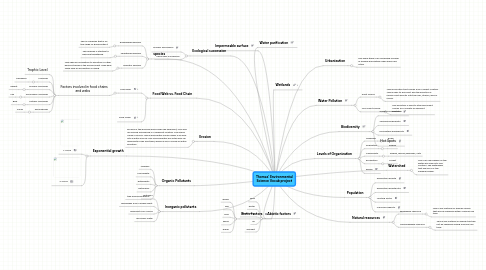
1. Food Web vs. Food Chain
1.1. Food Web
1.1.1. Factors involved in food chains and webs
1.1.1.1. Trophic Level
1.1.1.2. Producer
1.1.1.2.1. Dandelion
1.1.1.3. Primary consumer
1.1.1.3.1. Rabbit
1.1.1.4. Secondary consumer
1.1.1.4.1. Fox
1.1.1.5. Tertiary consumer
1.1.1.5.1. Bear
1.1.1.6. Decomposer
1.1.1.6.1. Fungi
1.2. Food Chain
2. Biotic factors
2.1. whale
2.2. hair
2.3. snail
2.4. apple
2.5. paper
3. Abiotic factors
3.1. sand
3.2. water
3.3. temperature
3.4. air
3.5. sunlight
4. species
4.1. Endangered species
4.1.1. This is a species that is on the verge of going extient.
4.2. Threatened species
4.2.1. This species is starting to become threatened.
4.3. Indicator species
4.3.1. This species is sensitive to pollution or other harmful things in the enviornment. They help show how an ecosystem is doing.
5. Ecological succession
5.1. Primary succession
5.2. Secondary succession
6. Exponential growth
6.1. J-curve
6.2. S-curve
7. Organic Pollutants
7.1. cleaners
7.2. food waste
7.3. detergents
7.4. petroleum
7.5. tree and brush debris
8. Inorganic pollutants
8.1. fertilizers
8.2. discharges from a power plant
8.3. sediment from runoff
8.4. acid from metal
9. Impermeable surface
10. Erosion
10.1. Erosion is the process were solids like sediment, rock and are moved and placed in a different location. One major cause is runoff. This is were water moves down a surface into a water source. This moving water will often pick up sediments rocks and trash, which is also a cause of water pollution.
11. Water purification
12. Wetlands
13. Levels of Organization
13.1. Organism
13.1.1. Robin
13.2. Population
13.2.1. Robins
13.3. Community
13.3.1. Robins, worms,sparrows, cats
13.4. Ecosystem
13.4.1. Forest
13.5. Biome
14. Biodiversity
14.1. Genetic biodiversity
14.2. Species biodiversity
14.3. Ecosystem biodiversity
14.4. Hot Spots
15. Population
15.1. Population growth
15.2. Population growth rate
15.3. Limiting factor
15.4. Carrying capacity
16. Water Pollution
16.1. Point source
16.1.1. This is pollution that comes from a direct location. This is easy to pin point and the pollution is usually sent directly intot he river, stream, lake or ocean.
16.2. Non-point source
16.2.1. This pollution is hard to stop because it comes for a variety of different locations.
17. Watershed
17.1. This is an area where all the water will drain into one location. The watershed that we are in is the Delaware Basin.
18. Natural resources
18.1. Renewable resource
18.1.1. This is any material or energy source that will be replaced within a human life time.
18.2. Nonrenewable resource
18.2.1. This is any material or energy that will not be replaced during a human life time.
